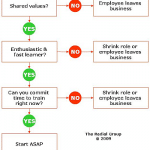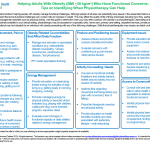Thrilled customers often want to work for your wellness business. These folks can be invaluable employees…or turn into your worst nightmare. They’re wonderful advocates, with first-hand experience with your program. They genuinely love singing your praises to prospects.
Yet they can can also pose special challenges. Use this guide to identify and troubleshoot the seven most common issues:
1. Hire for skills and enthusiasm.
It’s not enough to hire people who love your program and services. You need to hire people who actually have the skills and capabilities that your business needs right now.
What to do:
Follow your normal hiring process – reference and background checks, up-to-date resume, job application, practical assessments, and anything else you’d normally assess. That helps keep you objective – otherwise, it’s hard to look skeptically at someone who’s so enthusiastic about what you do!
Ask yourself if you’d hire this person for this job if he or she knew nothing about your business. Would they still have the right mix of professional strengths?
Think twice – even three times -before hiring someone who’s a raving fan but has only basic skills. Most wellness businesses really don’t have the time or resources to train someone who lacks key skills normally expected in their position.
And check your positive impressions with other staffers, who may have had different interactions with this individual.
2. Everyone’s just like me! Um, no.
When thrilled customers work in a sales or marketing role in your business, watch out for the mistaken assumption that every potential customer’s situation and needs will mirror theirs.
What to do:
It’s important to train customer-employees on active listening skills and all the features, benefits and advantages of your services. Otherwise they’ll tend to emphasize their own experiences rather than exploring the potential client’s situation. And they’ll zero in on the elements they liked the most, skipping over features that might matter more to others.
Emphasize to them that different customers have different needs. Some of those needs will indeed sound much like their own experience. Yet others will differ greatly.
Customer-employees often view it as a personal mission to win over every possible prospect. Remind them that your products and services may actually not be a fit for every prospective customer they talk to.
For example, if you offer a weight loss program designed specifically for yo-yo dieters, it really might not be a great fit for a woman struggling with first-time weight gain related to pregnancy. If you offer a premium-priced service, it’s not helping your business if they spend time with prospects who lack a willingness to pay.
3. The customer’s always right….employees, not so much.
Customers often find the expectations of an employee to be burdensome and unpleasant.
As a customer, if they missed a workshop or cancelled an appointment at the last minute you certainly didn’t sit them down and have a firm talk about expectations. At most, you charged a cancellation fee, right?
What to do:
It’s important to apply the same performance standards – and consequences – to customer-employees that you do to every other employee.
Set the right tone from the outset. Spell out your customer-employee’s job responsibilities and performance expectations early and often – and in writing to minimize confusion.
Put the new customer-employee through the same orientation you’d use for a traditional new hire. And, explicitly address the unique challenges of being both a customer and an employee. For example, if your customer-employee handles billing, it’s a good idea to emphasize the importance of keeping customer data private. If someone’s credit card was rejected, that information shouldn’t be gossiped about with other customers.
Take immediate action if your customer-employee doesn’t meet those expectations. For example, if someone misses scheduled shifts or bails at the last minute on work assignments, promptly sit them down and make sure they understand that this behavior is unacceptable and will result in termination if not immediately corrected.
4. They see all, they know all.
Your most enthusiastic customers probably put you up on a pedestal. In fact, it wouldn’t be a stretch to say that many customers are so grateful for the difference you’ve made in their lives that they really see you as an “angel of mercy.” And of course, they only see you at your best – because no matter what’s going on behind the scenes, you always put your best foot forward when it comes to clients.
Now, your customer is your employee – and they can see behind the curtain.
They realize that profit motivates some of your decisions – not just caring and compassion. Perhaps they see you speak sharply to someone. They certainly hear criticisms or negative comments about you, other managers, or the business from other employees – because no matter how happy a “family” you have, it’s rare that everyone’s upbeat and positive 24/7. And in most wellness businesses they probably hear some tacky and unnecessary – but all too common – comments from other staffers about certain customers.
What to do:
This cold dose of reality can be especially demoralizing to an employee who’s also a current or former customer.
When hiring a customer-employee for a behind-the-scenes role, assess whether their expectations are realistic or not. Are they likely to feel that their bubble has burst when they see you and other staffers stumble off that pedestal we mentioned? Will they handle negative feedback with maturity or will they crumble? Will they set a good example or pile on?
5. Customer-employees are only human.
Sometimes customer-employees fall off the wagon. They regain the weight they lost in your program. They stop working out even though they’re a member of your fitness center. They fall back into bad work/life habits, or they restart a risky behavior like smoking after completing a lifestyle change program.
What to do:
You may feel, for example, that someone who’s above a healthy weight can no longer represent your weight management program effectively. Or perhaps you feel that a relapsed smoker shouldn’t work in a business that helps people stop smoking.
We encourage you to first objectively assess the customer-employee’s performance. Are they performing their responsibilities well? Are they meeting performance expectations? We find that sometimes the real issue is a manager’s philosophical objection to the employee’s behavior rather than a true work performance impact. And sometimes managers assert that potential customers will be turned off, when the real issue is the manager’s personal dislike of the behavior in question.
If you decide that the backslide is indeed performance-affecting, work with your employment attorney to investigate the legal ramifications before changing employee responsibilities or terminating or demoting such employees. Because these behaviors are often health-related, special legal considerations may apply.
6. When love turns to hate.
It’s a sad truth that your biggest fans sometimes turn into your biggest critics. We’ve seen this pattern repeatedly in the health and wellness industry.
What to do:
Before you hire a customer-employee, check these warning signs:
- How do they handle frustrations, disappointments, and disillusionment?
- Do they seem to hold personal or professional grudges?
- Do they see a conspiracy to treat them badly around every corner?
- Have they job-hopped – and is it usually because they say they were treated unfairly?
- How do they respond to setbacks and criticism?
Don’t skip your normal hiring process. Check references and read between the lines of what you’re told by their references. Find out if they would be eligible for rehire at prior employers.
If you find yourself in this situation, don’t let their fury paralyze you. Develop a plan of action – terminate their employment, reassign them to other work, counsel them – and carry it out as you would with any other employee.
7. Imitation is the sincerest form of flattery…right?
We’ve seen customer-employees who enjoyed working in the business so much that they soon decided they’d like to open one just like it! Unfortunately, they “borrowed” program materials, instructor manuals, program design, and virtually every other bit of intellectual property developed by their employer.
What to do:
Well, you can’t prevent people from starting businesses that address the same health concerns you do. But you can protect material that your business developed.
Start by having every new employee sign a confidentiality agreement. Have them sign it again annually.
Then, when an employee leaves, schedule an exit appointment and have them formally return all of your documents to you – binders, presentations, etc. Have them sign a form stating that they’ve returned all materials to you. Remind them that their confidentiality agreement continues to be in effect even after their employment ends. And emphasize that you take legal protection of your program very seriously.
These actions will make former employees think twice before helping themselves to your hard work.




